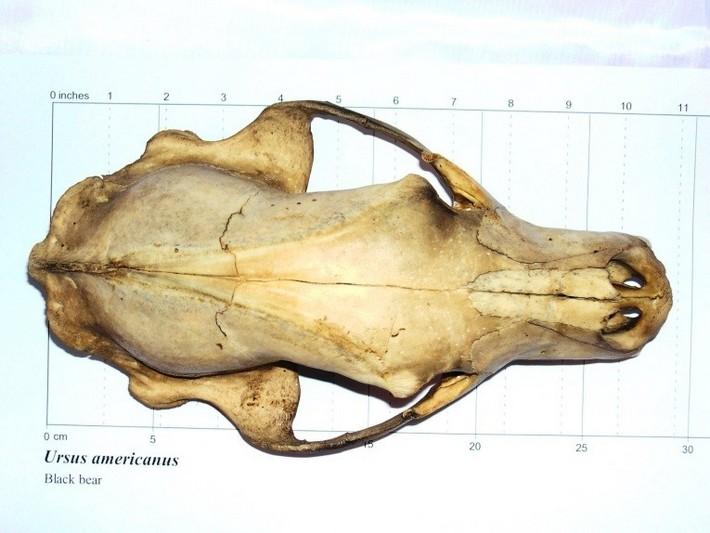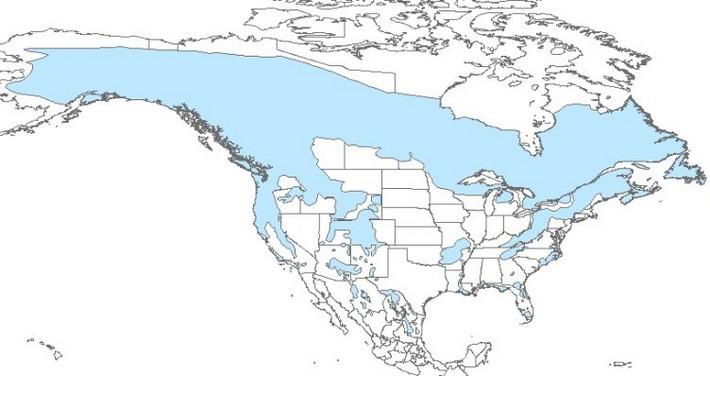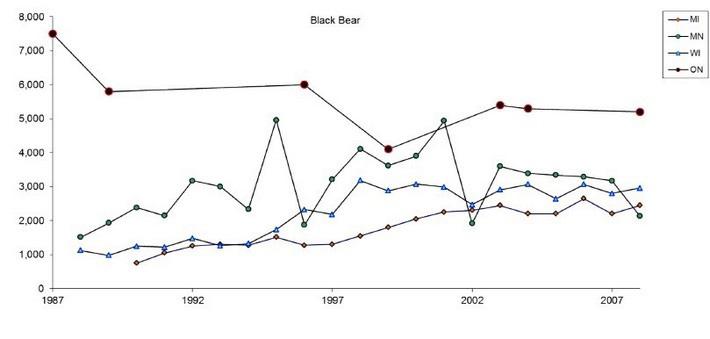
Description
Bears are large omnivores in the Ursidae family. Bears are distinguished from other carnivores by their size, stout body shape, round ears, long snout, and short tail. While fur color is generally black in the Great Lakes region, other color phases including brown, white, blue, and cinnamon are possible.
Size
Measurements from Minnesota are from Hazard (1982), from Wisconsin are from Jackson (1961), and from the Eastern United States are from Hamilton and Whitaker (1998).
Total length ranged from 53.9” to 70.9” (137-180 cm) in Wisconsin, and tail length ranged from 3.5” to 4.9” (9-12.5 cm) in Wisconsin.
Average adult body weight ranged from 250 to 300 lb (113-136 kg) in Minnesota, and 200 to 300 lb (91-136 kg) in the Eastern United States. Female body weight ranged from 225 to 450 lb (102-204 kg) in Wisconsin, while male body weight ranged from 250 to 500 lb (113-227 kg) in Wisconsin.
Males are typically larger than females.
Distribution & Status
Bears are found in less settled, forested regions of the United States and Canada. Bear populations have been extirpated or diminished in many accessible locations in the Midwest and East (Reynolds and Tapper, 1996; Scheick and McCown, 2014). Populations are secure in Ontario, Michigan, Wisconsin, and Minnesota, critically imperiled in South Dakota, and are presumed extirpated from North Dakota and Iowa.
Worldwide, Ursus americanus is restricted to North America. Other Ursus species occur throughout North America, South America, Europe and Asia.
Bears have an IUCN rank of Least Concern, IUCN information.
Incidence in Minnesota
Hunting for bear in Minnesota is typically allowed during a short period in early fall. In 2017, open season will be from September 1st through October 15th. Hunting and trapping are regulated by the Minnesota Department of Natural Resources, regulations.
Population Trends
To help assess population trends, we can look at regional furbearer harvest data, methods.
Regionally, bear populations are relatively stable or slightly increasing.
Life History
Bears are omnivores, eating berries when available, acorns in fall, some leafy vegetation, wild honey, carrion, and animal prey. Only a small percentage of bear diet is animal matter. Bears hibernate in colder months in brush piles, rock ledges, root balls, and similar shelter. Hibernation allows bears to slow their metabolic rate while only losing a few degrees in body temperature. It is critical for bears to put on a thick layer of fat during summer and fall in order to hibernate and deal with scarcer food in spring. Bears mate in midsummer, delayed implantation occurs, and 2-3 young are born after 7 months in late January or early February. Cubs stay with their mother through the second winter, and disperse in spring or summer as yearlings. Females typically breed every other year.
Contacts with Humans
Historically, bears were considered a threat to herding animals, and populations were reduced through payment of bounties and other harvest efforts. Loss of forested habitat also reduced bear numbers. Bears in wild landscapes typically avoid human contact. When individual bears associate humans as an easy source of food at garbage dumps, campgrounds, and towns, the potential for dangerous human-bear interactions increases. People should keep a respectful distance from all bears, especially female bears with cubs.



